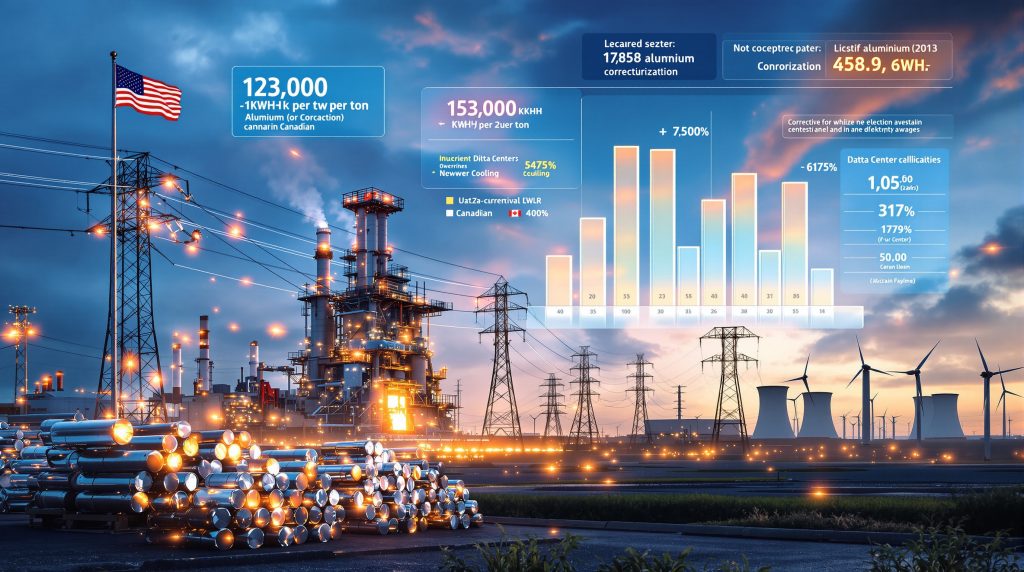Understanding the Energy-Production Relationship in American Aluminum Manufacturing
The relationship between electricity consumption and aluminum production represents one of the most energy-intensive processes in modern manufacturing. US aluminium smelting and energy costs remain inextricably linked, with power expenses determining the viability of domestic production facilities across the nation.
When examining the scale of energy requirements, a single aluminium smelter demands approximately 11 terawatt-hours of electricity annually, equivalent to powering metropolitan areas the size of Boston or Nashville for an entire year. This massive power consumption creates a direct correlation between electricity pricing and production economics that shapes the entire industry landscape.
Power Consumption Benchmarks for Smelting Operations
The energy intensity of aluminium manufacturing creates unique challenges for US producers attempting to compete in global markets:
• Electricity costs represent approximately 40% of total production expenses
• Power consumption accounts for roughly 80% of industry carbon emissions
• Single smelter annual consumption equals 11 terawatt-hours
• Production economics depend entirely on securing long-term, low-cost energy contracts
Industry experts emphasise that aluminium smelting requires consistent, uninterrupted power supply to maintain operational efficiency. The energy-intensive nature of the electrolytic process means that even minor fluctuations in electricity costs can dramatically impact profit margins and investment decisions.
What Makes US Electricity Prices Uncompetitive for Aluminium Production?
American industrial electricity rates have created substantial cost disadvantages compared to international competitors, particularly following energy market deregulation that began in 1977. This deregulation process fundamentally transformed the competitive landscape for energy-intensive manufacturing operations.
Current US Industrial Power Pricing Structure
The Aluminum Association reported significant variations in 2023 industrial power costs across states with idled primary aluminium capacity:
| State | Industrial Electricity Rate (per MWh) | Current Smelter Status |
|---|---|---|
| Kentucky | $65.50 | Idled capacity |
| Indiana | $82.40 | Idled capacity |
| South Carolina | $70-75* | Limited operation |
| Washington | $45-55* | Active production |
*Rates require verification from state utility commission data
International Cost Comparison Analysis
Canadian Competitive Advantage:
Canadian aluminium smelters maintain significant cost advantages through access to abundant hydroelectric power resources. Average purchased electrical costs for Canadian smelters range from $26.50 to $41.00 per megawatt-hour, creating a substantial pricing gap that has reshaped North American aluminium trade flows.
The United States sources nearly two-thirds of its primary aluminium from Canada, highlighting the direct relationship between energy costs and import dependence. This energy cost differential of $24-$56 per MWh below US rates represents a 60-100% cost disadvantage for domestic producers.
Competitive Threshold Requirements:
Industry analysis indicates that viable aluminium smelting operations require electricity prices below $40 per MWh with guaranteed long-term contracts spanning ten years or more. Current US industrial rates of $65-$82 per MWh exceed this viability threshold by 62-105%, making new investment economically challenging without substantial policy intervention.
How Are Data Centers Competing with Smelters for Electricity Supply?
The emergence of artificial intelligence and cloud computing has created unprecedented competition for industrial-scale electricity supply, fundamentally altering power market dynamics and pricing structures across the United States.
Data Center Electricity Demand Growth Projections
According to US Department of Energy reports, data center electricity consumption has experienced explosive growth:
| Year | Data Center Consumption (TWh) | Percentage of US Total | Growth Rate |
|---|---|---|---|
| 2014 | 48 | 1.8%* | Baseline |
| 2023 | 176 | 4.4% | 267% increase |
| 2028 (projected) | 325-580 | 6.7-12% | 85-230% additional |
*Percentage calculation requires verification
Price Competition Dynamics
The Aluminum Association describes data center electricity demand as price-inelastic, meaning consumption levels remain relatively constant regardless of price fluctuations. This characteristic allows technology companies to outbid traditional industrial electricity consumers significantly.
Critical Price Differential:
• Technology sector pricing tolerance: Up to $115 per MWh
• Aluminium smelter maximum viability: $40 per MWh
• Competitive gap: 188% price differential
• Market impact: Smelters cannot compete with unlimited technology sector budgets
The Constellation Energy agreement with Microsoft to reopen Unit 1 of the Three Mile Island nuclear plant in Pennsylvania demonstrates how technology companies can secure dedicated power supplies at premium rates, fundamentally reshaping electricity market priorities and availability for traditional industrial users.
As Jensen Huang, President and CEO of Nvidia, has emphasised, energy availability represents the primary constraint on AI technology expansion and profitability. This creates direct competition with traditional industrial electricity consumers, driving up prices and reducing availability for manufacturing operations.
Which Energy Sources Could Revitalise US Aluminium Smelting?
The path toward competitive American aluminium production requires strategic energy portfolio development, balancing cost considerations, reliability requirements, and environmental objectives to create viable long-term solutions. Furthermore, the integration of renewable energy solutions within industrial applications presents both opportunities and challenges.
Natural Gas Expansion Potential
The current administration's energy policy emphasises accelerated natural gas development through streamlined pipeline approval processes. In addition, insights from the US natural gas recovery suggest potential cost benefits for industrial users.
Policy Direction Benefits:
• Accelerated pipeline approvals to increase supply capacity
• Lower fuel costs compared to coal or nuclear alternatives
• Enhanced distribution networks for industrial customers
• Reduced emissions relative to coal-fired generation
However, natural gas expansion faces environmental trade-offs regarding greenhouse gas emissions and long-term sustainability commitments within the aluminium industry's carbon reduction goals.
Nuclear Power Renaissance for Industrial Applications
Small Modular Reactor (SMR) Technology Development:
Small modular reactors represent a potential solution for providing dedicated, baseload power to energy-intensive industrial operations. However, industry experts caution that significant development timelines create challenges for near-term solutions.
Richard Rast, CEO of Highland Materials, indicates that meaningful SMR deployment will require approximately one decade for significant commercial availability. The complexity of nuclear reactor construction means each subsequent facility effectively represents a first-of-its-kind engineering challenge despite standardised designs.
International Nuclear Integration Precedent:
Emirates Global Aluminium announced low-carbon aluminium production powered by the UAE's Barakah Nuclear Energy Plant in early August 2025, demonstrating nuclear power's capability for supporting large-scale smelting operations. This precedent provides a potential model for US industrial nuclear applications.
Nuclear Infrastructure Investment Requirements:
New nuclear facilities require substantial capital investment and extended development timelines. Large-scale nuclear plants demand $5-8 billion in initial investment with construction periods extending 8-12 years for completion.
Renewable Energy Integration Strategies
Solar and Wind Implementation Challenges:
Renewable energy sources face specific challenges for aluminium smelting applications due to the industry's requirement for continuous, uninterrupted power supply. Intermittency concerns create operational difficulties that require grid storage solutions or backup generation capacity.
Policy Uncertainty Impact:
The Trump Administration's One Big Beautiful Bill Act rolls back Inflation Reduction Act tax incentives for solar and wind energy development. This policy shift creates uncertainty regarding renewable energy investment economics and long-term project viability for industrial applications.
Renewable Integration Benefits:
Despite implementation challenges, renewable energy integration demonstrates proven capabilities for reducing both emissions and long-term price volatility for manufacturers. Clean power sources can provide substantial pollution reduction benefits whilst supporting community health improvements near production facilities.
What Investment Barriers Prevent New US Smelter Development?
Despite tariff protections and policy support, fundamental economic and infrastructure challenges continue limiting domestic aluminium production expansion and new facility development. Consequently, the mining industry evolution reflects broader challenges facing energy-intensive industries.
Capital Investment Requirements
New aluminium smelter development demands substantial financial commitments and extended timelines that challenge traditional investment models:
| Investment Component | Cost Range | Development Timeline |
|---|---|---|
| New smelter construction | $5 billion* | 5 years |
| Power infrastructure development | $1-2 billion** | 3-5 years** |
| Environmental compliance systems | $200-500 million** | 2-3 years** |
| Workforce development programmes | $50-100 million** | 1-2 years** |
*Source: Aluminum Association spring meeting
**Figures require verification from industry sources
Current US Smelting Capacity Analysis
Operational Facilities Status (2025):
The United States currently operates four primary aluminium smelters with a combined annual production capacity of 683,500 tonnes. Ownership distribution includes two facilities operated by Century Aluminum and two by Alcoa Corporation.
However, only two smelters currently operate at full capacity, indicating significant underutilisation of existing infrastructure. This operational pattern reflects the ongoing challenges of electricity costs and market competitiveness.
Historical Production Context:
The contrast with historical production levels demonstrates the scale of industry decline:
• 1980 peak production: Over 4.65 million tonnes from 33 sites
• Current capacity: 683,500 tonnes from 4 facilities
• Production decline: 85% reduction over 45 years
• Facility closure: 88% reduction in operating sites
The Aluminum Association identifies electricity price deregulation starting in 1977 as the single most important factor leading to the near total demise of the primary aluminium industry in the United States.
Century Aluminum Investment Example:
Century Aluminum announced a $50 million investment in early August 2025 to restart more than 50,000 tonnes of idled capacity at its Mt. Holly smelter in South Carolina. The company targets full capacity operation by June 30, 2026, demonstrating incremental capacity expansion rather than large-scale new development.
How Do Trade Policies Interact with Energy Costs in Aluminium Markets?
Section 232 tariffs have created market protection for domestic producers, but energy costs remain the determining factor for long-term competitiveness and investment decision-making across the aluminium industry. Moreover, the broader implications of tariffs and investment patterns affect industry development strategies.
Tariff Impact on Market Dynamics
Midwest Premium Evolution:
Fastmarkets assessed the daily aluminium P1020A premium at 74-76 cents per pound on September 29, 2025, reflecting tariff influence on domestic pricing structures. Whilst tariffs have successfully raised the Midwest premium, this protection has not translated into substantial new capacity development.
Industry Investment Response Patterns
Limited Investment Response:
Industry leaders emphasise that government expectations regarding tariff-driven capacity expansion overlook fundamental investment impracticalities. Long-term capital commitments require assurances regarding price stability and input costs, particularly energy expenses representing substantial production components.
William Oplinger, President and CEO of Alcoa, has indicated that long-term investment decisions cannot be justified by tariff protection alone without simultaneous access to long-term, low-cost energy contracts.
Century Aluminum Strategic Approach:
Century Aluminum specifically cited Trump's Section 232 tariff increases for its Mt. Holly smelter restart investment. However, the company continues pursuing additional smelter capacity development, requiring guaranteed access to massive quantities of reliable, uninterrupted, low-cost electricity.
Emirates Global Aluminum US Development:
Emirates Global Aluminium selected the Tulsa Port of Inola in northeastern Oklahoma as the site for its proposed US smelter. The company remains in negotiations with Public Service Company of Oklahoma regarding power contract terms, with investment scale potentially reaching multi-billion dollar commitments.
What Role Will Environmental Regulations Play in Future Smelting Operations?
Climate policies and emissions standards increasingly influence aluminium production strategies, creating both regulatory challenges and competitive opportunities for domestic manufacturers pursuing sustainable operations. Similarly, the broader context of US uranium production illustrates how energy resource development affects industrial competitiveness.
Carbon Footprint Considerations
Industry Emissions Profile:
Aluminium production accounts for approximately 2% of global greenhouse gas emissions, with electricity consumption driving 80% of smelting-related emissions. This emissions profile creates opportunities for substantial pollution reduction through renewable energy integration and technology upgrades.
Environmental Benefits of Energy Transition:
Switching to renewable energy sources and innovative technologies can reduce pollution substantially, providing benefits for environmental protection and community health near production facilities. Clean power integration demonstrates proven capabilities for lowering both emissions and long-term price volatility.
Clean Energy Incentive Programmes
Inflation Reduction Act Implications:
Federal programmes established under the Inflation Reduction Act created opportunities for investments in renewable energy systems and technology upgrades that could reduce costs and emissions simultaneously, potentially improving American aluminium competitiveness in global markets.
However, the Trump Administration's efforts to dismantle these programmes through the One Big Beautiful Bill Act may limit opportunities for clean energy integration and technological advancement within the aluminium sector.
Policy Uncertainty Challenges:
Relying primarily on fossil fuel energy sources creates sustained high pollution levels and exposes manufacturers to volatile power cost fluctuations. Policy uncertainty regarding renewable energy incentives complicates long-term investment planning for sustainable production systems.
Future Outlook for US Aluminium Smelting Energy Economics
The intersection of energy policy, technological advancement, and market dynamics will determine whether American aluminium production can achieve long-term competitiveness in global markets through strategic energy partnerships and infrastructure development. Furthermore, US aluminium smelting and energy costs will continue to be the primary determinant of industry viability.
Strategic Priorities for Industry Development
• Expanding low-cost power generation through diverse energy portfolio development
• Creating innovative financing mechanisms for industrial energy contract structures
• Developing policy frameworks that balance environmental goals with manufacturing competitiveness
• Coordinating stakeholder efforts across government, utilities, and industry participants
Investment Decision Factors
Success in revitalising US aluminium smelting and energy costs competitiveness will require addressing the fundamental energy cost disadvantage that has limited domestic production for decades. Industry participants emphasise that sustained electricity prices below $40 per MWh with guaranteed long-term contracts represent essential prerequisites for viable operations.
Technology Integration Opportunities
Small modular nuclear reactors and renewable energy systems offer potential pathways for achieving competitive energy costs, though implementation timelines and capital requirements create near-term challenges. The UAE's successful integration of nuclear power for aluminium production provides an international precedent for clean energy solutions.
Market Competitiveness Requirements
Domestic aluminium producers must compete simultaneously with low-cost international suppliers and price-inelastic data center electricity demand. This dual competitive pressure requires coordinated policy responses addressing both energy infrastructure development and industrial competitiveness support.
The future of US aluminium smelting and energy costs depends fundamentally on creating sustainable, affordable power supply solutions that can support the energy-intensive requirements of modern aluminium production whilst maintaining global competitiveness and environmental responsibility.
Looking to Capitalise on Industrial Energy Shifts?
Discovery Alert's proprietary Discovery IQ model delivers real-time alerts on significant mining and energy discoveries across the ASX, transforming complex market data into actionable investment insights for both energy transition opportunities and traditional resource plays. Explore historic examples of major mineral discoveries that have generated substantial returns, then begin your 30-day free trial today to position yourself ahead of the market as industrial demand reshapes commodity landscapes.




